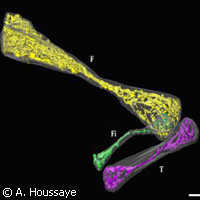Sophisticated technology reveals ancient snakes' origins
Where did snakes come from? A European team of researchers has discovered that today's snakes evolved from a terrestrial lizard, not from one that lived in the oceans. The findings, presented in the Journal of Vertebrate Paleontology, could help scientists understand how snakes evolved to slither their way along the different paths in their lives. The researchers from Germany and France used an innovative X-ray imaging technique from the Grenoble-based European Synchrotron Radiation Facility (ESRF) to generate three-dimensional (3D) images of one of the few fossils of a snake that had legs. The images reveal that the ancient snake's leg bones have an internal architecture that is highly similar to that of the leg bones of modern terrestrial lizards. Innovative in design, synchrotron laminography was developed specifically for studying large, flat samples. While it is like the computed tomography (CT) technique used by hospital staff, it uses a coherent synchrotron X-ray beam to resolve the tiniest details, just a few micrometres in size - around 1,000 times smaller than a hospital CT scanner. Using this latest technique, the researchers rotated the fossil at a tilted angle in a brilliant high-energy X-ray beam, recording thousands of two-dimensional (2D) images as it made a full 360-degree turn. They reconstructed a high-resolution 3D representation of these individual images, revealing hidden information including the internal structures of the ancient snake's legs. The ESRF's Paul Tafforeau, one of the authors of the study, says: 'Synchrotrons, these enormous machines, allow us to see microscopic details in fossils invisible to any other techniques without damage to these invaluable specimens.' Led by Alexandra Houssaye from the Muséum National d'Histoire Naturelle (MNHN) in France, the researchers said only three specimens exist of fossilised snakes with preserved leg bones. For the purposes of their study, the team assessed Eupodophis descouensi, an ancient snake that was first discovered a decade ago in Lebanon in rocks that were 95 million years old. The 50-centimetre (cm) long specimen shows a small, 2 cm long leg attached to its pelvis. According to the researchers, this fossil will play a key role in helping scientists better understand the evolution of snakes. 'It represents an intermediate evolutionary state when ancient snakes had not yet completely lost the legs they inherited from earlier lizards,' they say. The fossil actually shows just one leg on its surface, but thanks to this latest technology, the researchers were able to reveal the second leg, which was thought to be hidden in the stone. The high-resolution 3D images, say the researchers, give hints that this species lost its legs because they grew more slowly or for a shorter period of time. Their findings also show that the hidden leg is bent at the knee and has four ankle bones. However, it has neither feet nor toe bones. 'The revelation of the inner structure of Eupodophis hind limbs enables us to investigate the process of limb regression in snake evolution,' explains Dr Alexandra Houssaye, the lead author of the study. Also participating in this study was the Karlsruhe Institute of Technology in Germany, which developed an advanced technique and a dedicated instrument to take the images.For more information, please visit: Journal of Vertebrate Paleontology:http://www.vertpaleo.org/publications/index.cfmEuropean Synchrotron Radiation Facility (ESRF):http://www.esrf.eu/Muséum National d'Histoire Naturelle (MNHN):http://www.mnhn.fr/
Countries
Germany, France



